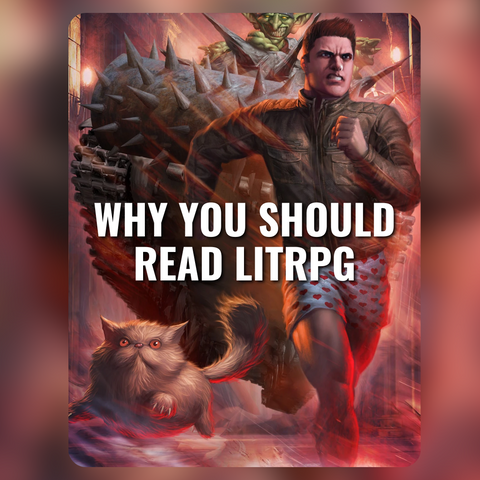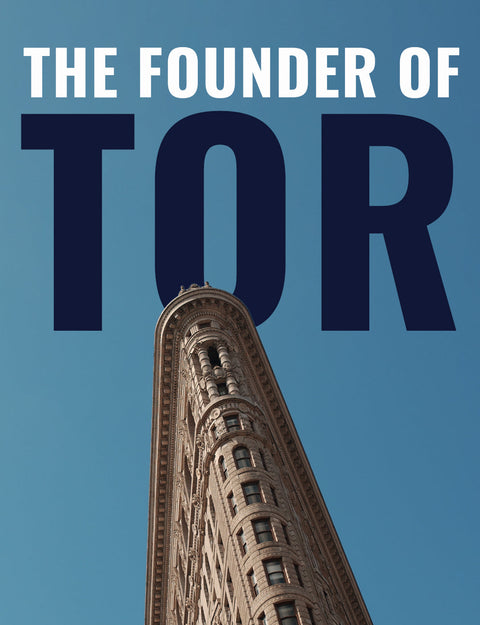At JordanCon this year, I attended a panel on a topic that’s been buzzing around Dragonsteel HQ. LitRPG is a rapidly growing subgenre that's reshaping fantasy literature, and I knew I needed to do a rundown on why it’s taking over the book world.
Though I do dabble with video games, they’re rarely the crunchy ones with stats and levels and the like. So, this was a special opportunity to hear the details from industry experts.
Here's what I learned about this fascinating genre and why it might be your next obsession.
What is LitRPG?
WARNING: Small spoiler for Dungeon Crawler Carl, Book 1 in this section, though it only spoils up to page 20.
LitRPG—short for Literary Role-Playing Game—blends traditional storytelling with video game mechanics. The term popped up sometime in 2013, and has since gained massive popularity worldwide, especially among readers who are also gamers (looking at you, Sanderfans).
Genre is how a reader experiences a story. LitRPG is a layer you can add to many different kinds of stories. So, LitRPG can be a genre all on its own or can be explored in tandem with a familiar favorite (such as fantasy).
What makes this genre unique is its integration of game-like elements as essential components of the narrative. Characters level up, acquire skills, and their stats are visibly tracked throughout the story. And it’s more than stats, other video game elements are represented narratively. For example, in the popular series Dungeon Crawler Carl by Matt Dinniman, the first book features Carl’s surprise when a floating text dialogue box appears in front of him.
“I kicked at the floating words with my foot, and the too-small Croc went flying. I hopped over and quickly shoved my foot back in. The words moved with me, floating just a few feet in front of my face.”
What follows is paragraphs of text providing Carl with instructions for the “World Dungeon,” an 18-level adventure rolled out in front of him, as they would be in a video game. Fun, right?
“World dungeon? What the actual hell? What did that even mean? My mind continued to race. I immediately thought of Pathfinder and Dungeons and Dragons and other games I hadn’t played since I was on active duty.”
As for how the stats appear, the crunchy part of things, even Carl’s cat, Donut, gets the full treatment.

“Crawler #4,119. ‘Princess Donut.’ Level 1. Race: Cat. Class: Not yet assigned.”
You know when you do something in a game and all the sudden you’re bombarded with a bunch of random achievements and rewards you have to click through? Yeah, this book even has that experience within the text.

Core Elements of LitRPG
For a work to qualify as true LitRPG, it needs several key components:
- A Game-Like System: The story must include a structured system with rules, often displayed through character stats, skill trees, or level progression.
- Progression as a Theme: There's an umbrella of a theme across the whole genre, and that is progression. Characters grow stronger in measurable, quantifiable ways.
- The System as a Character: The system itself is integral, because it itself is a character. The game mechanics actively shape the narrative.
- Crunchiness: The "crunchiness" of a LitRPG refers to how detailed the numerical aspects are. Some books feature extensive stat blocks and detailed mechanical explanations, while others take a lighter approach.
5 Popular LitRPG Subgenres
Since its inception, the genre has expanded dramatically, spawning tons of subgenres that appeal to different readers. A few of the most popular subgenres are:
1. Dungeon Crawlers
These stories focus on characters navigating dangerous environments filled with monsters, traps, and treasures. What makes LitRPG dungeon crawlers unique is that sometimes the dungeon itself is a character with its own progression system and motivations.
2. Tower Climbers
A variant of a dungeon crawler, in a way, where characters must ascend (or sometimes descend) through levels of increasing difficulty. Each floor often presents a completely different environment or challenge, creating a natural progression structure. The tower climber idea is a good tool because it's such an easy visual—the higher a character climbs, the closer it is to the goal. The difference between a dungeon crawler and a tower climber is that a tower climber typically has more distinct settings per floor, where dungeons are usually more visually consistent.
3. Empire/Town Building
These stories expand beyond individual character progression to involve community development. As characters gain power, they establish and grow settlements, manage resources, and build infrastructure. This creates a natural expansion of the narrative scope, as the world grows with us.
4. Cultivation LitRPG
Drawing inspiration from Eastern fantasy traditions, cultivation stories focus on characters harnessing inner energy to strengthen their bodies and spirits. When combined with LitRPG elements, this creates a compelling system for character advancement.
5. Apocalypse LitRPG
Set during or after world-ending events that mysteriously introduce game systems to reality. An apocalypse is an example of a great setting for a LitRPG, because you can easily show that before there was no system, and now, after this huge catastrophe, we have this system. In fact, if you start browsing the LitRPG landscape, you’ll likely see a plethora of stories set during some sort of apocalypse for that reason.
Why Readers Love LitRPG
The appeal of LitRPG extends beyond simply gamifying literature:
- Tangible Character Growth: Readers can see concrete evidence of character development through stats and abilities.
- Streamlined Worldbuilding: Game mechanics provide a familiar framework that reduces exposition needs.
- New Forms of Tension: Will the character gain enough experience points before the big battle? Can they find the resources needed to craft a crucial item? LitRPG introduces novel sources of narrative tension.
- Wish Fulfillment: Many readers enjoy the fantasy of becoming powerful through hard work and clever strategy rather than destiny or birthright.
- The Cost of Power: Interestingly, many LitRPG stories eventually explore the responsibilities and challenges that come with great power, adding depth to what might otherwise be simple power fantasies.
Should You Try LitRPG?
If you enjoy any of the following elements, LitRPG might be worth exploring:
- Fantasy or science fiction settings
- Character-driven stories about growth and self-improvement
- Strategic problem-solving
- Detailed magic or advancement systems
- Video games or tabletop RPGs
- Stories that balance action with quantifiable progression
Popular LitRPG Series to Start with
For those curious about the genre, here are some highly recommended entry points:
- The Land series by Aleron Kong
- The Dungeon Crawler Carl series by Matt Dinniman
- The He Who Fights with Monsters series by Shirtaloon
- The Defiance of the Fall series by TheFirstDefier
The Next Level
LitRPG continues to grow in popularity, with increasing potential for crossover into mainstream fantasy and even adaptations to other media (see Matt Dinniman’s recent deal to turn the Dungeon Crawler Carl series into a TV show). The genre's structured progression systems provide clear visual frameworks that could translate well to television, film, or actual video games. It will be exciting to see how these works evolve across different mediums in the future.
As traditional fantasy publishers begin to recognize the commercial potential of this once niche genre, we expect to see more professionally published LitRPG titles reaching wider audiences.




Comments (4)
I also am reading Dungeon Crawler Carl, and I think the RPG game mechanic to the game is such a great addition to literature. I am currently reading the 6th floor, and this book has accomplished something no other series has accomplished; I have legitimately laughed out loud multiple times for the shenanigans Princess Donut and Carl get into. Somethings it is an actual event/activity, sometimes it is something the main characters say, or even the creepy, horny AI inputs. Super weird and fun. Thanks for the article!
Just started book 2 of the Dungeon Crawler Carl series. Reading the first, I thought “Why on Earth had I never thought of mashing RPG elements and fantasy writing before?” It really is a genius mode of storytelling. Glad to see coverage of this from Dragonsteel!
So glad to see LitRPG getting turned into a legitimate genre by the industry. There is a wide appeal, not just for video-gamers and isekai fans, but for all generations.
I also like that the genre is in its infancy, so inexperienced writers are able to step in and get that experience and exposure that will make them great someday, while also helping to shape what the future of the genre comes to be defined as.
Hey, I like reading the articles. No one wrote a comment here, so I wanted to make sure you knew you weren’t screaming out into the void. I always at least skim through them. Thank you for the articles, your voice is heard. I just wanted to let you know that.